Probably because I grew up in the careless and tasteless 1950’s, before Lady Bird pointed out that the landscape was filling with garbage, but after logging and poverty had been pretty well trashed my neck of the woods — that is, because I had a visually impoverished childhood — I find living in this city a continuing visual delight.

Even the rain has its moments.
So I thought for as a bit of thanks-giving, I would meander around Portland Oregon, pointing out the sights that I like. Some of these are constant public presences, like the statue of Harvey Scott in Mt. Tabor Park. Scott was a city “father” as well as an anti-suffragist newsman. (I keep scheming of ways to bring his perfidy to the attention of the city mothers).
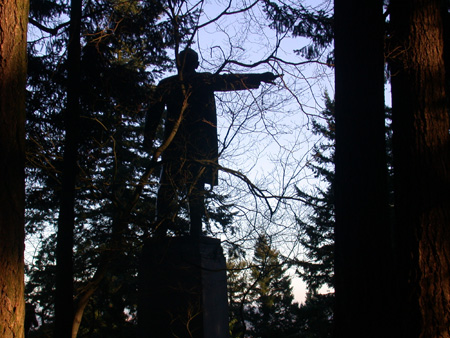
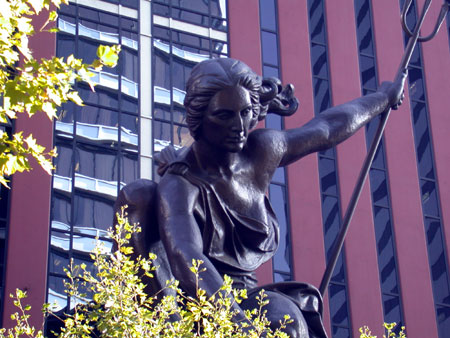
Some of the things I love were obviously planned by good designers, but some happen just because I was there at the right time.
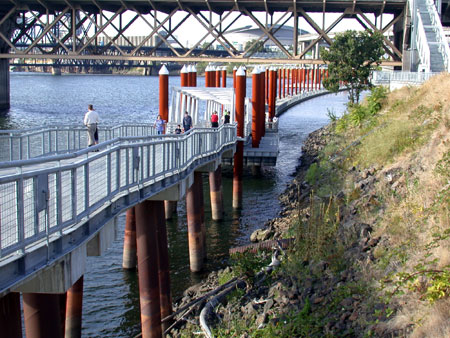
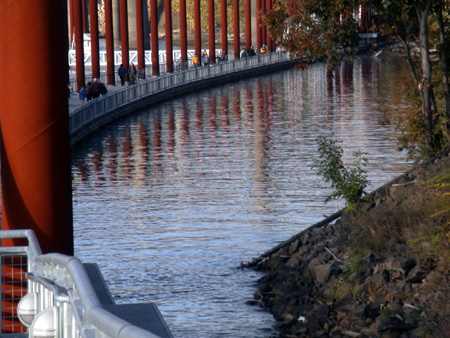
When I started thinking about this, I thought I’d divide the photos into “public” and “private” but I quickly lost track of what those divisions actually meant. Every photo I took was something open to the public, and many of the items were put together by public groups (if not publicly funded). But all resulted in my public — and private — enjoyment.
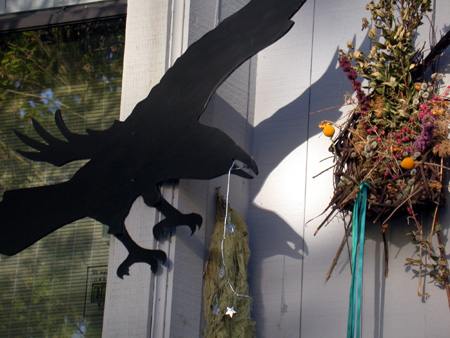
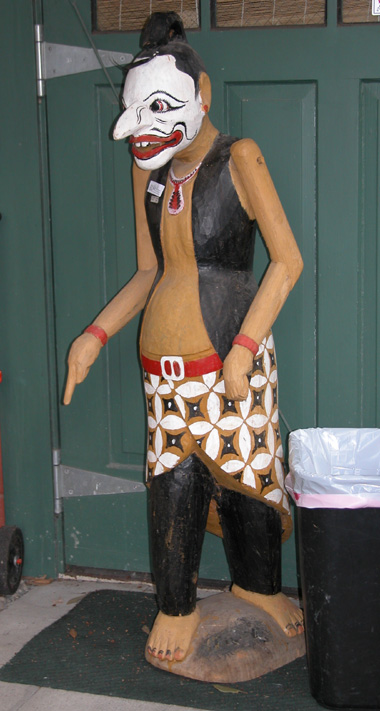
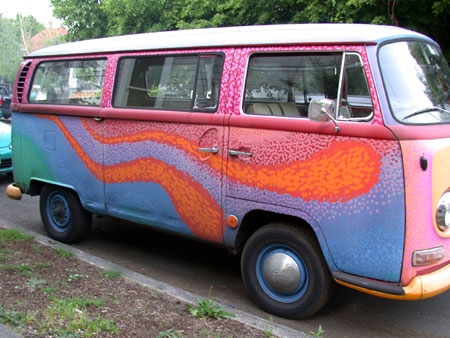
It’s not that I’m so solipsistic as to believe that Portlanders were thinking of me when they polka-dotted their VW buses, but rather, I believe that the spaces that we have in common, even if they are privately held, are seen in this city as having public ramifications.
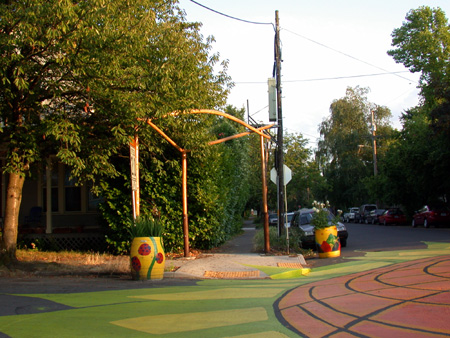
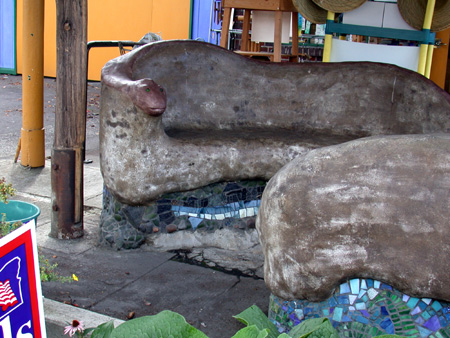

Of course, there’s the house pride that makes my streets charming:
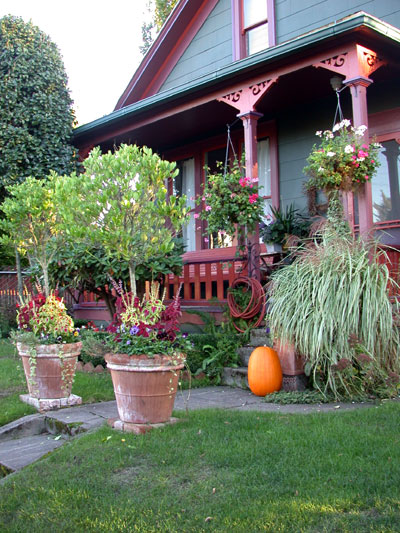
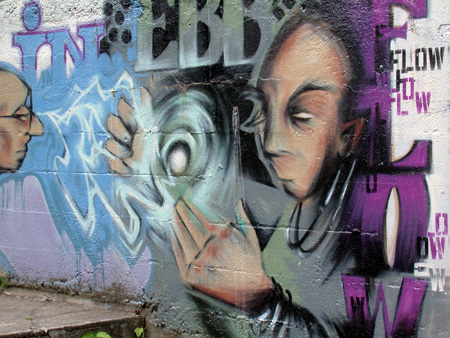
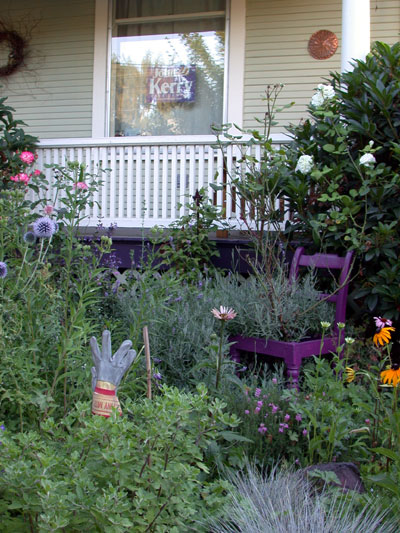
And the rusting scupture below, on the Eastbank Esplanade, is one of my favorites. It’s underneath both an interstate highway and the Morrison Bridge (one of seven that links the plebian eastside of Portland to the toney west). The sculpture is one of my favorites in part because it’s part of a serendipitous photo that I took. Here’s a rather ordinary view:
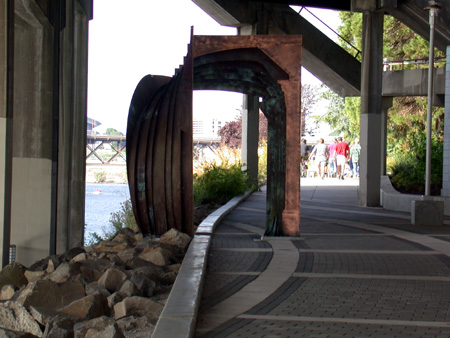
But here’s another photo of that sculpture, taken from the opposite direction, that I return to often:
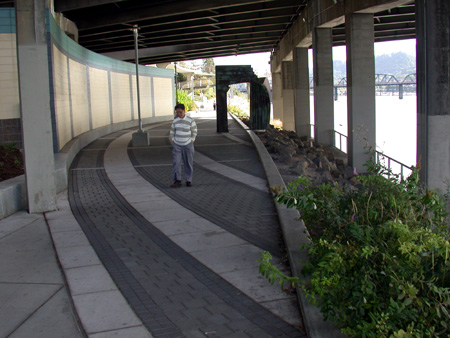
Some places I walk by change frequently. This rather kitschy scene is a memorial to a bicyclist killed at this corner by a car, and different items appear on it almost daily. They are all somewhat tacky, but poignant in the way of memorabilia. I like thinking about the intimacy of this memorial against the pomposity of my friend on Mt Tabor, pointing the way out of the city.
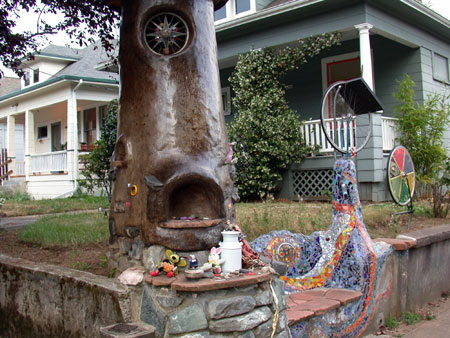
And finally, here’s another place that changes frequently, another one that I make a point of going back to often. It’s a poetry place, maintained by a householder who also conducts writing workshops. Poems appear here, some on paper, pinned to the bulletin board, some laid under rocks to hold them down, and some printed on other material.

Who remains standing?
First,
Erase your name,
Unravel your years
Destroy your surroundings,
Uproot what you seem,
And who remains standing?
Then, rewrite your name,
Restore your age,
Rebuild your house,
Pursue your path,
And then,
Endlessly,
Start over, all over again.
Andree Chedid
Egyptian poet
I suppose this meander might bring questions to mind:
What are the human elements of your milieu that please you, that you return to again and again, that, even if they aren’t aesthetically pleasing, please something in your psyche or mind’s eye?
And have you ever started over, all over, again?

June,
Thank you for showing us Portland. I spent a very happy week there visiting friends in the midseventies. I remember the artichoke plant in their front yard. I loved the colorful houses in their neigborhood and was impressed by the huge rhododendrons extending above houses.
You made me think about what I value in East Lansing – the sculpture of a girl throwing off her chains; the office window of a friend in the neigborhood, small, obscured by a huge tree stem and with an active mind behind it; the house across the street because I love Denise, an artist who started making jewelry in bed after she broke her back picking up her sick dog. I bought one of her necklaces, mudstones, asymmetrically arranged.
And have I ever started over again? I am working on it with all of your help.
Birgit,
As I understand it, Portland has changed immensely from the mid-seventies — but that was when Tom McCall, a famous mayor then governor, ripped up a downtown freeway and made a park; he also passed the bottle bill and is responsible for making the beach a “public highway” and thereby keeping development off it. He is revered, and reviled, among Portlanders . The Esplanade is officially named for Vera Katz, another visionary mayor of the city who left not too long ago.
Somehow the rhodies above the houses and the artichokes in the front yards exude some kind of serendipitous aura that the city collectively seems to live off of. Perhaps it’s a form of pan-consciousness (I’ve already forgotten the term that McFawn brought to our attention, but the concept, that rocks have consciousness, remains with me.
My favorite places in Bozeman are the alleys, where you can appreciate the reality of lives, as opposed to the facades street-side. I especially like the alleys downtown, behind the brick commercial buildings, each wall a palimpsest with traces of former tenants.
But your question made me realize I don’t really have specific favorite spots as I did when I lived in Sendai, Japan, perhaps because I walk less here, or perhaps because of the centrifugal pull of the mountains around that take us away at every opportunity. In Japan I had favorite spots along the river, favorite little shrines where I would leave a chocolate bar on occasion, the parks we went to for the cherry blossom festival, etc. None of these in either town were anything you’d find a postcard of, but they had personal significance because of time spent there.
Regarding place, I’ve started over quite a few times. I always enjoy it. I can easily imagine living around the world, moving every year or two…
June,
When your yellow tree picture first came up on my screen, I could only see the top half of it and I thought it was a piece of fiber art and I was studying it trying to figure out how you did it!
My brother and family live in Boring, so I’ve seen Portland many times and love the art community there
Steve,
Alleys are rare these days, so cherish what you have. There’s an old “development” near us, built on a radius out from a central park (with four other rose gardens along the way out from the radius) which has alleys. I too like them, although now everyone has fences instead of the old open back yards that I remember from the olden days.
I leave obos, little cairns of stones, here and there on my walks. It’s fun to see which ones remain or are added to by unknown fellow pedestrians.
The city has a very different appeal to me than does the outback.
Karen,
I actually made a fiber piece using the gingko/rain motif. It wasn’t nearly as nice as the photo. I thought the way the photo scrolled down to the rainy reflection here on the blog was a nice touch.
Thanks for checking in.
June:
They certainly logged the hell out of your hills. There’s a logging museum up by Coudersport with a display of photos in which the mountains appear to have been attacked by a huge Norelco. Thank goodness nothing like that has ever happened in Oregon.
I believe that you picked a good place to settle.
My grandparents fed those PA loggers — near Coudersport,in fact, up on the Pike. And indeed, clear cutting looks like an advance over what they did to the Pennsylvania mountains in 1900. My father knew of some places up Pine Creek gorge, hidden away, where the loggers gave up for some reason — left a crosscut saw stuck halfway into a tree which grew around it. That was where I first encountered old growth forest.
What astonishes me is that the battles over logging and saving the environment go back to the turn of the 20th century — there’s the California resevoir (hetch-hetchy?) that the Federation of Women’s Clubs fought against. Legend attributes the leadership to John Muir but I know that the women were in there fighting.
http://www.hetchhetchy.org/history.html
In a visit to the Mt. St. Helens’ visitor center in the mid-90’s I saw an exhibition of newspapers from the days leading up to the volcanic explosion. That was 1980 and the volcano shared the headlines with logging fights. The only difference between then and now is that the amount of old growth (then about 15% and in 2000, less than 5%).
I feel blessed living in a city where it’s harder to see the ravages of nature — most of it has already happened (add a snort here)
I live and work in an area so rural and remote that I’m often frustrated and stir-crazy, imagining all the hopping art scenes elsewhere. But I do get the curious experience of hearing the hooves of Amish buggy horses as the trot by on the pavement.
Country living is romantic, but one has to be self-sustaining and resolute to make art in a place so divorced from any “scene.”
McFawn:
Pleased to meet you.
My grandparents were Amish and they were nice in an offish kind of way, but no bundle of fun. The best you can hope for with that group is to get into distlefinks.